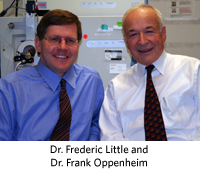Analytical Chemistry Journal Highlights Saliva Research
An article highlighting the research that is part of a collaboration between Boston University Goldman School of Dental Medicine (BUGSDM) Professor and Chair of Periodontology and Oral Biology Dr. Frank Oppenheim, Boston University School of Medicine (BUSM) Assistant Professor Dr. Frederic Little, BUGSDM Associate Professor Dr. Eva Helmerhorst, BUGSDM Research Assistant Professor Dr. Walter Siqueira, Tufts graduate student Timothy Blicharz, BUSM graduate fellow Philip Wexler and Robinson Professor of Chemistry at Tufts University Dr. David Walt was published in the February 4 edition of Analytical Chemistry.
The article is titled, “Fiber-Optic Microsphere-Based Antibody Array for the Analysis of Inflammatory Cytokines in Saliva,” and describes the techniques used to develop a multi-analyte, antibody array.
This array simultaneously measures 10 inflammatory protein indicators in saliva from patients with pulmonary inflammatory disease. The idea behind the research is that these protein indicators will one day be used to diagnose and select treatment for patients by matching the patterns present in the array with patterns that are known to exist in the saliva of patients with different types of pulmonary inflammatory disease.
“The quickness and availability of results makes saliva testing attractive to pulmonary patients,” said Dr. Little. “But there is a lot of intelligence that needs to be gathered in a discovery phase before we can know what patterns are in saliva. We are currently collecting all 10 analyte measurements from hundreds of patient saliva samples and we’ll correlate these with what we know is going on clinically in the patients through subject questionnaires, dental exams, physical exams, and cataloging of medication they’ve taken in the past and present.”
Dr. Oppenheim believes that the ability to look at 10 analytes together will allow physicians to give a more accurate diagnosis. He added, “Most systemic diseases don’t manifest themselves only in a single body fluid parameter. There are typically many biomarkers present which show a pattern. If you look at the whole pattern of 10 analytes you’re much safer in diagnosing or controlling the patient than if you only measured a single parameter.” Dr. Oppenheim continued, “The point is that the multiplexing of analysis is really the way to go.”
“I am very pleased that through this collaboration our faculty are doing their part to demonstrate that BUGSDM is an integral member of what President Brown describes as a great urban research university,” said Dean Jeffrey Hutter. “I applaud their efforts and their collegiality.”
